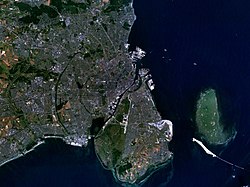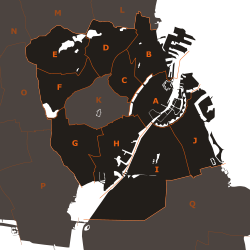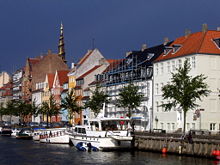Copenhagen
![]()
This article is about the capital of Denmark. For other meanings, see Copenhagen (disambiguation).
Copenhagen (Danish ![]() [kʰøb̥m̩ˈhɑʊ̯ˀn], in spelling valid until the 19th century Kjøbenhavn) is the capital of Denmark and the cultural and economic centre of the country (Primatstadt). The city is the seat of parliament (Folketing) and government, as well as the residence of Queen Margrethe II of Denmark.
[kʰøb̥m̩ˈhɑʊ̯ˀn], in spelling valid until the 19th century Kjøbenhavn) is the capital of Denmark and the cultural and economic centre of the country (Primatstadt). The city is the seat of parliament (Folketing) and government, as well as the residence of Queen Margrethe II of Denmark.
The Danish capital is one of the most important metropolises in Northern Europe, a popular tourist destination and port city. The municipality of Copenhagen (Københavns Kommune) has 638,117 inhabitants, the capital in the formal sense (consisting of the municipalities of Copenhagen, Frederiksberg and Gentofte) 816,344 inhabitants. Copenhagen is part of the Danish administrative region Region Hovedstaden and the binational metropolitan region Öresund Region.
The city is considered one of the cities with the greatest quality of life in the world. In the 2018 city rankings of the consulting firm Mercer, it ranked eighth in this category among 231 major cities worldwide.
In the Copenhagen metropolitan area (Hovedstadsområdet), the population is 1,336,982 (as of 1 January 2021).

Satellite image
Place name
In Middle Danish, the town was called Køpmannæhafn, which can be translated as "merchants' port" or "port of the merchants" and thus expresses the importance of the merchants in the Middle Ages. In 1043, the town was first mentioned as Havn - parallel to the Latinized form of the name Hafnia for "harbour".
In Icelandic the city is still called Kaupmannahöfn, as well as Keypmannahavn in Faroese; in Swedish the name is Köpenhamn and from here in Finnish Kööpenhamina. The German and Dutch exonyms Copenhagen correspond to English Copenhagen, French, Spanish and Portuguese Copenhague, Polish Kopenhaga and Estonian Kopenhaagen; in Czech and Slovak the name is Kodaň.
The asteroid (13586) Copenhagen and the chemical element 72 hafnium were named after the city.
Geography
Location
The urban area of Copenhagen is spread over several islands. The larger western part lies on the east coast of Zealand (Sjælland), the largest Danish island in the Baltic Sea, as well as Denmark's largest island (excluding Greenland). The eastern part of the city includes a collection of smaller so-called holms and the northern half of Amager. Copenhagen and Malmö, located in Swedish Scania, are separated by the Öresund strait.
Geology
Geologically, the entire city is located on the Cenozoic glacial ground moraine landscape that occupies large parts of Denmark. At Copenhagen, the moraine rests on relatively high limestone consisting of Upper Cretaceous (Maastrichtian) chalk limestone, which caused significant problems during the construction of the metro.
Climate
| Copenhagen Airport Kastrup, Amager Island | ||||||||||||||||||||||||||||||||||||||||||||||||
| Climate diagram | ||||||||||||||||||||||||||||||||||||||||||||||||
| ||||||||||||||||||||||||||||||||||||||||||||||||
| Monthly average temperatures and precipitation for Copenhagen Airport Kastrup, Amager Island
Source: Danmarks Meteorologiske Institut (DMI): Normaler for Danmark Klimadata 1961-1990 (Memento of 13. April 2012 in the Internet Archive); wetterkontor.de | |||||||||||||||||||||||||||||||||||||||||||||||||||||||||||||||||||||||||||||||||||||||||||||||||||||||||||||||||||||||||||||||||||||||||||||||||||||||||||||||||||||||||||||||||||||||||||||||||||||||||||||||||||||||||||||||||||||||||||||||||||||||||||||||||||||||||||||||||||||||||||||||||||||||||

The districts of Copenhagen Municipality (since 2007) are highlighted in black.

The Christianshavn district
Search within the encyclopedia